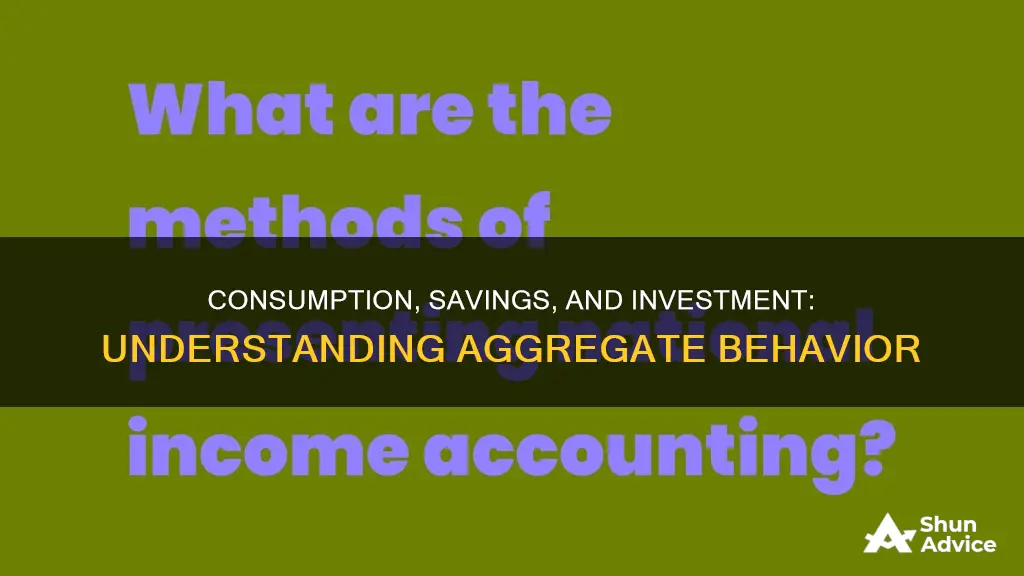
Consumption, savings, and investment are fundamental components of a country's economy. Consumption is the total amount of goods and services demanded by individuals and households, while savings is the portion of income that is not spent. Investment, on the other hand, refers to businesses' spending on capital goods, such as equipment and factories, to support current output and increase production capacity. These three components are interconnected and play a crucial role in shaping a country's economic trajectory. Understanding the dynamics between consumption, savings, and investment is essential for economists and policymakers to make informed decisions about monetary and fiscal policies, guiding the country's economic growth and stability.
What You'll Learn

Consumption function and its determinants
The consumption function is an economic formula that represents the relationship between total consumption and gross national income (GNI). It was introduced by British economist John Maynard Keynes, who argued that the function could be used to predict total consumption expenditure. The consumption function is a valuable tool for understanding the economic cycle and guiding economists and policymakers in making key decisions about investments, monetary policy, and fiscal policy.
The consumption function is based on the relationship between income and spending, or the income-consumption relationship. It is represented as C = f(Y), where C is consumption, Y is income, and f is the functional relationship. This relationship assumes that all other factors remain constant, and only the income-consumption relationship is considered. The consumption function suggests that consumer spending is wholly determined by income and changes in income.
The consumption function can be calculated using the formula: C = A + MD, where C is consumer spending, A is autonomous consumption (spending regardless of income levels), M is the marginal propensity to consume (the amount of additional income needed to spend on goods and services rather than saving), and D is the amount of real disposable income required.
The consumption function is influenced by various determinants, which can be categorised into subjective and objective factors:
Subjective Factors:
- Psychological characteristics of human nature: This includes basic values, attitudes, states of mind, etc. For example, a consumer who expects a rise in income or price level may consume more.
- Social practices and institutions: Social customs, habits, and social arrangements can influence consumption patterns.
- Behaviour patterns of businesses: This includes wage and dividend payments, retained earnings, and social arrangements affecting income distribution.
Objective Factors:
- The rate of interest: An increase in interest rates may discourage consumption as it encourages saving. However, empirical evidence suggests a weak link between interest rates and consumption.
- Volume of wealth: The total wealth position of consumers, including assets such as shares, bonds, and property, can influence consumption decisions.
- Terms of consumer credit: The popularity of the hire-purchase system for buying durable goods depends on the terms and conditions of credit. Reasonable credit terms can lead to a spending spree.
- Deferred payment: Consumer spending may decline during certain periods, such as wartime, due to restraints on spending. Once these restraints are removed, there may be a rise in spending.
- Income distribution: The marginal propensity to consume (MPC) is typically higher for low-income families, so a redistribution of income in favour of low-income families can lead to an increase in aggregate consumption.
- Demographic factors: Factors such as family size, stage in the family life cycle, place of residence, and occupation can influence consumption spending, although these factors may be less significant in the short-term analysis.
- Changes in fiscal policy: Heavy commodity taxation and public expenditure can affect the consumption function by reducing disposable income. Progressive taxation and welfare programmes can shift the consumption function upward by altering income distribution.
- Changes in expectations: Changes in future expectations, such as anticipating a war or expecting lower prices, can affect the propensity to consume. For example, people may hoard durable goods in anticipation of future scarcity, leading to an increase in consumption.
- Changes in the rate of interest: Substantial changes in interest rates may influence the consumption function indirectly by affecting the price of bonds or encouraging saving instead of investing in bonds.
- Financial policies of corporations: Corporate financial policies regarding income retention, dividend payments, and reinvestments can impact the consumption function. For example, if corporations retain more profits as reserves, dividend payments to shareholders will be lower, reducing their income and consumption.
- Holding of liquid assets: The amount of liquid assets, such as cash balances, savings, and government bonds, can influence consumption. Holding more liquid assets may lead to a higher propensity to consume.
- Attitude towards saving: If individuals value future consumption over present consumption, they may tend to save more, leading to a decrease in consumption.
Solow Model: Investment Savings Strategy for Long-Term Growth
You may want to see also

Investment function and its determinants
The investment function is an economic strategy or concept that identifies the connection between shifts in investment patterns and other variable factors affecting investment in an economy. The investment function is the relationship between the amount businesses plan to invest and the level of income in the economy.
The simplest investment function assumes that planned investment is independent of the level of income. However, in reality, there are three factors that are considered when making an investment decision: the cost of the capital asset, the expected rate of return from it during its lifetime, and the market rate of interest.
The determinants of investment include:
- The current level of income: Higher current income increases production demands and boosts the demand for capital.
- The market interest rate: Lower interest rates increase investment.
- Business expectations: Positive expectations increase aggregate expenditure, while negative expectations reduce it.
- The stock of capital: A higher existing stock results in more investment to replace depreciated capital, but a higher stock may also result in less investment as less may be needed.
- Capacity utilization: The higher the current rate of capacity utilization, the more likely that investment plans will be realized.
- The cost of capital goods: Higher prices of capital goods lower the marginal efficiency of capital and lower investment demand at every interest rate.
- Other factor costs: If capital and labour are substitutes, a higher wage rate will induce greater capital investment, increasing labour productivity and lowering labour costs.
- Technological change: New technologies often require greater capital investment.
- Public policy: Accelerated depreciation, investment tax credits, lower taxes on corporate profits, and a lower capital gains tax increase the demand for capital goods.
There are two types of investment:
- Induced Investment: Depends on profit expectations and is directly influenced by the income level. Induced investment is income elastic, meaning it increases when income increases and decreases when income decreases.
- Autonomous Investment: The investment on which the change in income level does not have any effect and is induced only by the profit motive. Autonomous investment is income inelastic, meaning that if there is a change in income, the autonomous investment will remain the same.
Equity Saving Schemes: A Guide to Investing Wisely
You may want to see also

Government spending and its determinants
Government spending is a key component of aggregate expenditure, which also includes consumption, investment, and net exports. Government spending represents the demand generated by government programs, such as infrastructure spending and public goods. The level of government spending can vary depending on several determinants, which can be categorised into two main groups: economic factors and political factors.
Economic Factors Influencing Government Spending
Economic factors play a significant role in shaping government spending. One of the key determinants is the level of economic growth. As a country's economy expands, government revenue tends to increase, providing more resources for spending. This can lead to higher government expenditure on various programs and initiatives. Conversely, during economic downturns or recessions, government revenue may decrease, leading to potential cuts in spending or budget deficits.
Another economic factor is the level of government revenue, which includes taxes and other sources of income. Higher revenue can enable increased government spending, while lower revenue may require spending cuts or adjustments. Additionally, the level of public debt can influence government spending. A higher debt burden may limit the government's ability to spend, as a significant portion of revenue may be allocated to debt servicing.
Demographic factors, such as population growth and urbanisation, also come into play. A growing population can increase the demand for public services, infrastructure, and social welfare programs, leading to higher government spending. Similarly, urbanisation trends can impact government spending patterns, as urban areas often require more significant investment in infrastructure and public services.
Trade openness, which refers to a country's participation in international trade, can also influence government spending. More open economies may experience increased government spending to facilitate trade, provide social security, and address risks associated with dependence on foreign markets.
Political Factors Influencing Government Spending
Political factors are equally important in determining government spending. The preferences and priorities of citizens can shape government spending decisions. For example, if citizens demand improved healthcare or education, the government may allocate more resources to these sectors. Additionally, the power dynamics between politicians, bureaucrats, and citizens can impact spending. Politicians may pursue spending policies that align with their ideological beliefs or seek to maintain their political power.
The constitutional design of a country's government also influences spending. Different levels of government, such as federal, state, and local, have varying responsibilities and budgetary constraints, which can affect spending levels and priorities.
Electoral systems and political ideologies can also play a role. For instance, democratic governments may adjust spending based on election cycles, and ideological shifts can lead to changes in spending priorities.
In conclusion, government spending is influenced by a multitude of economic and political factors. These factors interact in complex ways, and their relative importance can vary across countries and over time. Understanding these determinants is crucial forsection analysing and predicting government spending patterns, as well as for developing effective fiscal policies and managing public finances.
Saving and Investing: Your Path to Financial Freedom
You may want to see also

Net exports and their determinants
Net exports are calculated by subtracting the total value of a country's imports from the total value of its exports. They are one of the four components of aggregate expenditure, alongside consumption, investment, and government spending. The other three components are influenced by income levels, and net exports are no different. As a nation's income increases, so too does its propensity to import goods and services, thus reducing net exports. A decrease in income will have the opposite effect, increasing net exports.
However, there are other factors that can influence net exports, and these can be grouped into two categories: domestic and foreign.
Domestic Determinants of Net Exports
- Exchange rates: If the price of a nation's currency increases relative to another, its goods become more expensive for foreigners, and so exports will decrease. Conversely, imports will increase as foreign goods become cheaper. This will result in a decrease in net exports and a downward shift of the net exports line.
- Trade barriers: If a country successfully uses trade barriers, such as tariffs or subsidies, to gain a competitive advantage, net exports will increase. Conversely, if other nations are successful in increasing their exports to your country, net exports will decrease.
- Interest rates: Higher interest rates can lead to reduced consumption and, therefore, reduced imports. Lower interest rates can have the opposite effect, increasing consumption and imports, and thus decreasing net exports.
- Expectations of future prices: If consumers expect higher prices for real assets, current consumption may increase, and net exports with it. Conversely, if they expect higher prices for financial assets, consumption may decrease, increasing net exports.
Foreign Determinants of Net Exports
- Global prosperity: When other nations are in good economic shape, there is an increase in consumption and investment, which can result in an increase in net exports. A decline in global prosperity will have the opposite effect, reducing net exports.
- Income levels in other countries: As income levels in other countries increase, so too does their propensity to import, which will increase net exports. A decrease in income levels will reduce net exports.
These factors can trigger shifts in the net exports line, which represents the relationship between net exports and income. An increase in net exports is illustrated by an upward shift of the line, while a decrease is shown by a downward shift. These shifts can cause a small amount of business-cycle instability as equilibrium is disrupted. An upward shift corresponds with a business-cycle expansion, while a downward shift corresponds with a business-cycle contraction.
CDs: Macroeconomics Investment or Savings Strategy?
You may want to see also

Aggregate demand and its determinants
Aggregate demand is a macroeconomic term that refers to the total demand for all finished goods and services in an economy at a given price point. It is commonly expressed as the total amount of money spent on those goods and services at a specific price level and point in time. Aggregate demand is influenced by several factors, including consumer spending, investment spending, government spending, and net exports.
Consumer spending, or consumption, is the demand for goods and services by individuals and households within the economy. It is influenced by factors such as disposable income, consumer confidence, and the level of taxation. When disposable income increases, consumers are more likely to spend more, leading to an increase in aggregate demand. On the other hand, if disposable income decreases, consumers may cut back on their spending, resulting in a decrease in aggregate demand.
Investment spending represents businesses' investments to support current output and increase production capability. It includes spending on new capital assets, such as equipment, facilities, and raw materials. Investment decisions are often based on expected rates of return and the interest rates at which businesses can borrow funds for these investments. Lower interest rates, for instance, can encourage businesses to borrow more for investments, leading to an increase in aggregate demand.
Government spending is another component of aggregate demand and includes spending on infrastructure, public goods, and various government programs. Changes in government policies and budget allocations can impact aggregate demand. For example, an increase in government spending on public projects can boost aggregate demand, while cuts in government spending may lead to a decrease.
Net exports refer to the difference between the value of a country's exports and imports. When a country's exports exceed its imports, it has a trade surplus, contributing positively to aggregate demand. On the other hand, when imports exceed exports, resulting in a trade deficit, it detracts from aggregate demand.
It is important to note that these components of aggregate demand are interconnected and can influence each other. For instance, an increase in consumer spending may lead to higher demand for imported goods, impacting net exports. Similarly, changes in government spending can affect consumption and investment decisions.
In summary, aggregate demand is influenced by a combination of factors, including consumer behaviour, business investment decisions, government policies, and international trade. These factors interact in complex ways, and changes in one area can have ripple effects on the overall level of aggregate demand in an economy.
Mortgages: Investment or Saving? Understanding Your Financial Future
You may want to see also
Frequently asked questions
The consumption function, introduced by John Maynard Keynes, is an economic formula that represents the relationship between total consumption and gross national income (GNI). It can be used to predict total aggregate consumption expenditure. The formula is: C = A + MD, where C is consumer spending, A is autonomous consumption, M is the marginal propensity to consume, and D is the amount of real disposable income required.
Saving refers to storing money safely for future use, typically in a savings account or a certificate of deposit (CD). It is a way to meet short-term financial goals and prepare for unexpected situations. On the other hand, investing involves taking on some risk by putting money into financial instruments such as stocks, bonds, and mutual funds, with the potential for higher returns over the long term.
Savings and investment are both critical elements of personal finance and play a significant role in the economy. They help individuals build financial security and plan for the future. From an economic perspective, savings contribute to economic growth by providing funds for investment, while investment leads to the accumulation of capital and the production of goods and services.







